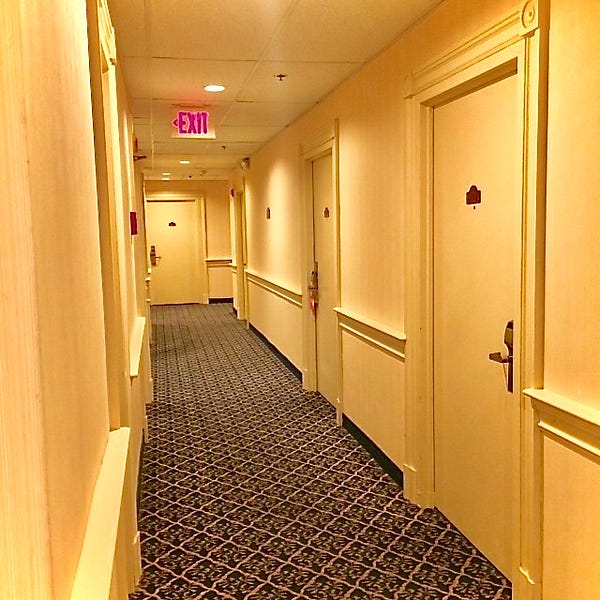Rainy June, Stamford, Connecticut: The electrical feeling in my left foot jars me awake, my leg inadvertently kicking to relieve the sensation. It’s not painful, exactly, just intensely uncomfortable. A convulsion in my nerve endings. I sit up, massaging my foot. What time is it? Outside my hotel, the sky is rainy and lifeless. The spasms come every 20 seconds or so. Half a foot-rubbing hour later, I check the clock. It’s too early for sunrise. The false dawn I saw was the security lighting from an office building.
This was supposed to be my morning to sleep in. No deadlines loom, my final destination is a few hours away by car, and most relevent for me, last night I fell asleep quickly — within half an hour. Tonight I catch up on sleep, was my last, delicious thought before falling asleep. I’d felt calmer than I had in weeks.
But it isn’t really deadlines that so often keep me awake. It isn’t even the Restless Leg Syndrome. That only began after I’d already been experiencing years of sleepless nights. Insomnia is as much a part of happy, calm times as it is tumultous times. It’s ingrained in my soul, deep as my name or eye color.
The heat of a shower relieves the craziness in my feet. After six, I decide to go downstairs for coffee. In the hotel hallway, the silence feels carpeted. Sleep is a heavy presence behind all those locked doors. Seems everyone is sleeping but me. I have a habit of filling this apparent reality with meaning, seeing it as a terrible proof:
THERE’S SOMETHING WRONG WITH ME.

Walking to the elevator, I feel ill from being so tired. But something is missing. I’m not plagued by a familiar question. It’s the same question that plagued comedian, impersonator, and actor Darrell Hammond for years.
WHAT’S WRONG WITH ME? In my bones, deeper than my name, deeper than insomnia, lay a fault line. Mingled with my distinct awareness of self, I always knew there was something seriously wrong with me. I used what felt like scattered outbreaks of normalcy to convince myself that I was normal. Wasn’t I?
But now, I’m only asking if the free hotel coffee will be as bad as I expect. This exhaustion isn’t me. I knew I wouldn’t be ruminating, all day, on my essential defectiveness. I knew the insomnia would resolve in time. It wasn’t a big deal. Downstairs, I gave the guy setting out doughnuts a heartfelt smile.
There are several reasons for this sea change.
- The simplest reason is summed up in a line from the new documentary about Hammond, Cracked Up. It stays with me like a memorized fortune cookie fortune:
You are NOT bipolar/schizophrenic/multiple personality disordered/obsessive compulsive: “You are this way because of something that happened to you.”
After being diagnosed with practically everything in the book, Hammond’s 11th psychiatrist spoke these life-changing words. Hammond always knew that “something” bad had happened to him as a child, but he had no clear memories. Only flashes. Terrors, the worst one involving hallucinations of the color red. He knew crack houses. Rehabs. Hospitalizations. Once, he was carried off the SNL set in a straitjacket. All these were real, and they were terrible. But that 11th psychiatrist, at the 11th hour of Hammond’s frayed sanity, conveyed the most important message a traumatized person can hear: his essential person was not defective. This brief, profound truth meant that instead of continuing to spin around in chaos, Hammond could take the first, dizzy steps toward healing.
Child abuse is only one of the developmental traumas that can increase a child’s likelihood of adult ill-health. In short, these traumas are called ACES (Adverse Childhood Experiences). Child abuse of any kind is up there at the top of the list, but so are parental death, divorce, having a battered mother, etc. ACES have been studied in combat soldiers: the higher the ACE score, the more adult trauma results from war experiences. A high ACE score is also linked to adult diseases like cancer and diabetes.
Hammond’s got me beat, symptom-wise. I’ve never seen a straitjacket except in movies. But where the shame of abuse is concerned, it doesn’t matter if a trauma symptom is as minor as clearing your throat occasionally in public. If you are expressing the internalized presence of any kind of shame-inducing abuse, ANY symptom makes you feel like a total freak.
Here are the life-lessons I share with ‘philosopher’ Darrell Hammond (the same guy who, playing Bill Clinton, said to an imaginary Monica Lewinsky, “If you just take your clothes off and let me see you naked, America will no longer have a problem with racism.”) (Watch the trailer. You gotta see it.)

Link to Cracked Up Trailer
2. Shame is Central. I can’t imagine that Hammond felt exactly Yay Me! about being the one actor on SNL with wrist-cuts that were visible to the entire watching public — at the time, cutting himself was the only thing that made his flashbacks go away. Me, I’ve always been ashamed to mention my garden-variety symptoms. Not because they seem so minor, but because each one expresses the shame my abusers injected into me. For a child, shame is protective. It’s a way of rationalizing the unthinkable: that the adults we rely on to survive actually arethe monsters in the closet. If you can’t tell anyone about the abuse, which was the case with both me and Hammond, childhood is only navigable if you believe that YOU are the problem. Until we begin to heal, we carry that shame forward in our symptoms. Even as adults, shame-symptoms mask fears that feel too overwhelming to face.
3. ‘Listening’ to our bodies helps us heal. It took a wise doctor to help Hammond begin to listen to the symptoms his body was throwing at him. I do this in silent meditation, sometimes in yoga. I tend to avoid these calming practices like the plague: a sure sign of wanting not to feel something I’d rather not feel.
But in recent months, I’ve been able to tune into some of the terrifying feelings behindthe dread of waking up too early. Believe it or not, this is a huge relief. After all, it’s not ME. The turn-around came when I began studying and exploring the nature of shame. I discovered that this primary human emotion is something we allshare.
Sleep is vulnerable. It’s dangerous. I might be attacked.
Rationally, I know this isn’t true. I have a very safe life (now) and a very safe partner snuggled next to me. But trauma symptoms, by definition, are rarely rational. They make sense only in the context of trauma — because the experience of trauma is itself irrational, marked by chaos rather than reason.

Recently, I did some yoga with a quiet mind after meditation. I went through the poses slowly, allowing myself to not move with my usual goal of looking like a 20-year old. The feeling was there: Right in the cells and muscles of my body. Danger.It’s with me all the time, but it’s taken years of healing to feel such clarity in my body. My typical antidote? Hyperactive productivity, AKA anesthesia. I don’t feel a thing.
I’m incredibly good at overriding fatigue, which is one reason I keep changing things up in my house. (Spray painting our cat was a whim.)
4. Everyone heals differently. There’s a scene in Cracked Up where Hammond tells his yoga teacher how his sleep has improved from doing yoga. While yoga and meditation definitely calm me, I’ve rarely experienced that either one improves my sleep. Paradoxically, accepting and feeling my symptoms is far more conducive to rest. In the past, I would have taken the contrast between Hammond’s yoga experience and my own as a personal failure — further proof that I’m defective. The fact that I’m out of Hammond’s league, symptom-wise, wouldn’t have made any difference — because my symptoms are fueled by shame. It could take me a long time to undo the formula that says REST = DANGER. But it’s only a symptom. It’s not me. And that is huge.
5. Finding people who ‘get you’ is essential. In the documentary, Hammond tells his best friend from childhood that making the film “felt great.” If he can help even one person, (I paraphrase here), it’s not just worth it — it’s better than being on national television or having performed for four US Presidents. Hammond’s diagnosis of Multiple Personality Disorder turned out to be something his abuser threw at him even as an adult, and whatever professional diagnosed him with that one didn’t offer a whole lot of hope. With the 11th-hour psychiatrist, Hammond felt understood. Seen.Big difference.
For me, becoming free(er) from shame has been a game-changer. The most profound shame-healing experience I’ve had came not from being with any of the 20-odd therapists (count ‘em!) I’ve encountered throughout my life, but from peers. I’m blessed with lots of friends, but I’m not talking about friends per se. It baffled me — and fueled even more shame — to know that even though none of these friends would consider any of my symptoms especially shameful, telling them about my anxieties always felt like admitting that I enjoy cannibalism. In truth, I was putting my friends “above” me somehow — a symptom of internalized shame.
I’m talking about someone like my best friend D., who, in very different life circumstances than mine, also entered adult life with a ton of internalized shame. Sharing one’s own shame with someone who is only not able to hold your story in its entirety, but to offer her own shame to you for safekeeping, is tremendously healing. Yes, it takes time. But that’s what best friends are for. (Learning about ACES was also very helpful.) In Hammond’s case, a psychiatrist offered him the key to unlocking years of behavior that, I have to assume, was largely driven by shame.
I’ll never perform a killer Bill Clinton, Al Gore, George W. Bush, or anyone else, with the possible exception of my mother. But I consider Darrell Hammond a kind of soul mate. And he’s about the same age as me, but damn, we both look good, considering.
A free screening of the full documentary will be shown in Philadelphia in October, 2019. Please email me if you’d like to attend. (click on address) hmallon@navpoint.com Screenings will also be in various other cities this fall. In some cases, Hammond and filmmaker Michelle Esrick will be fielding questions. https://www.crackedupmovie.com/events-3
Note to DSM geeks: I know that Multiple Personality Disorder is now called Developmental Identity Disorder, with some variations on the theme. Hammond, however, was diagnosed at one point with MPD.
Restless Leg Syndrome: It’s a real thing. Check the link. And no, cutting out coffee didn’t help.
This story was first published on Medium.




Comments (6)